
Lower-income countries have benefitted more from the increase in technology transfers due to globalisation
Editor's note: This article originally appeared on VoxEU.
Cross-border patenting has become a key channel for the international transfer of technology. As such, it plays a major role in fostering development (Manysheva et al. 2022). Technology transfers are crucial in promoting structural transformation and productive capacity in the Global South, and facilitating sustainable development within the framework of Sustainable Development Goals (SDG). This channel is more prominent in the 21st century, with technological change taking place at higher speeds and mostly within global networks (Nicita 2023). Moreover, “[t]oday, FDI is not only about capital, but also – and more important – about technology and know-how . . . International patterns of production are leading to new forms of cross-border investment, in which foreign investors share their intangible assets such as know-how or brands in conjunction with local capital or tangible assets of domestic investors” (Qiang et al. 2015). Recognising the crucial role of technology and cross-border patenting for economic growth and sustainable development, many developing countries have created favourable environments to attract foreign direct investment (FDI) and foreign technologies by ensuring that inventors and companies can protect their intellectual property rights (IPR) beyond national borders.
Motivated by the growing interest in understanding the determinants of cross-border patenting (Howard et al. 2023) and the role that IPR play in shaping these decisions (Coleman 2022), we build a new comprehensive panel dataset on intra-national and cross-border patents (LaBelle et al. 2023). We deploy this dataset within a quantitative model to estimate the effects of various determinants of cross-border patents and to gauge the importance of international technology transfers for development and real income inequality.
A new database on ‘International Patents and Citations across Sectors’
The new International Patents and Citations across Sectors (INPACT-S) database tracks cross-border and domestic patent flows across industries over four decades. INPACT-S is free, publicly available, and more comprehensive than other available datasets along five key dimensions:
- It encompasses a wider array of patent authorities, offering a full view of global patent activity
- It provides industry-specific bilateral data, allowing us to do sectoral analysis
- It captures a greater number of patent applications through imputation methods
- It includes comprehensive data on cross-country and cross-sector citation data
- It includes consistently constructed data on cross-border and domestic patents
Table 1 summarises the key features and dimensions of INPACT-S.
Table 1 INPACT-S: Dimensions and key features
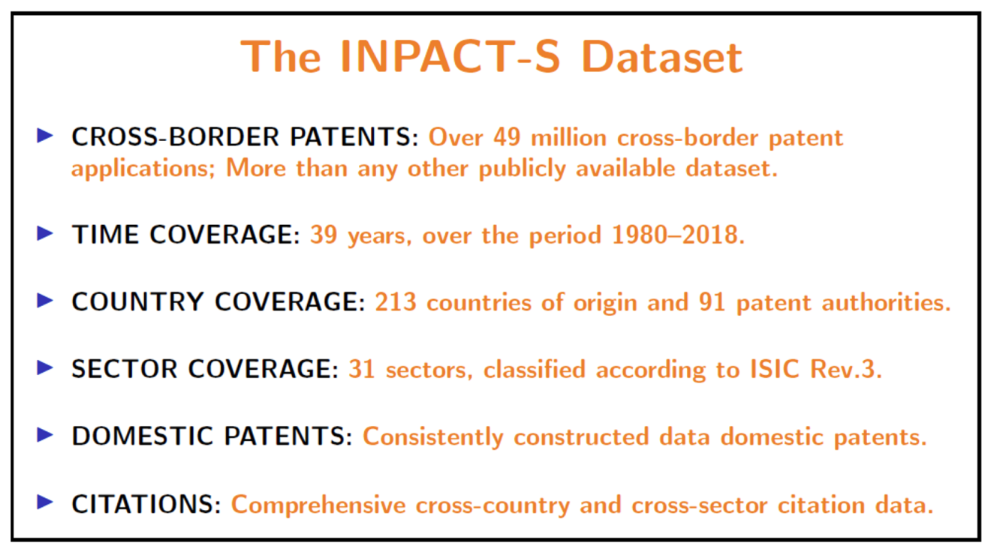
INPACT-S uncovers several key features of the origins and destinations of innovation, highlighting significant changes observed over time. First, patent applicants are concentrated in a few countries across Europe, North America, and East Asia (Figure 1), with notable domestic patent applications in China and Russia (Figure 1a).
Figure 1 Origins of innovation
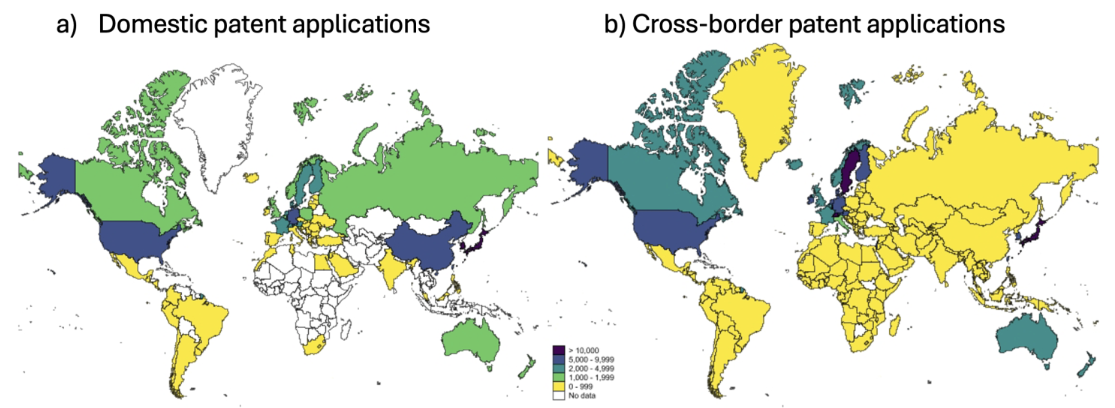
Source: Authors’ elaboration using INPAC-S dataset. Note: Number of patent applications per million people in the 2010s.
Second, Asia has emerged as an innovation hub in the last two decades, with China and Taiwan establishing themselves as new powerhouses in the 2010s (Figure 2b). East Asia has been steadily catching up to North America in terms of foreign applications filed in the mid-2000s, and has maintained the lead ever since (Figure 2a).
Figure 2 Patent evolution by region of origin
a) World regions
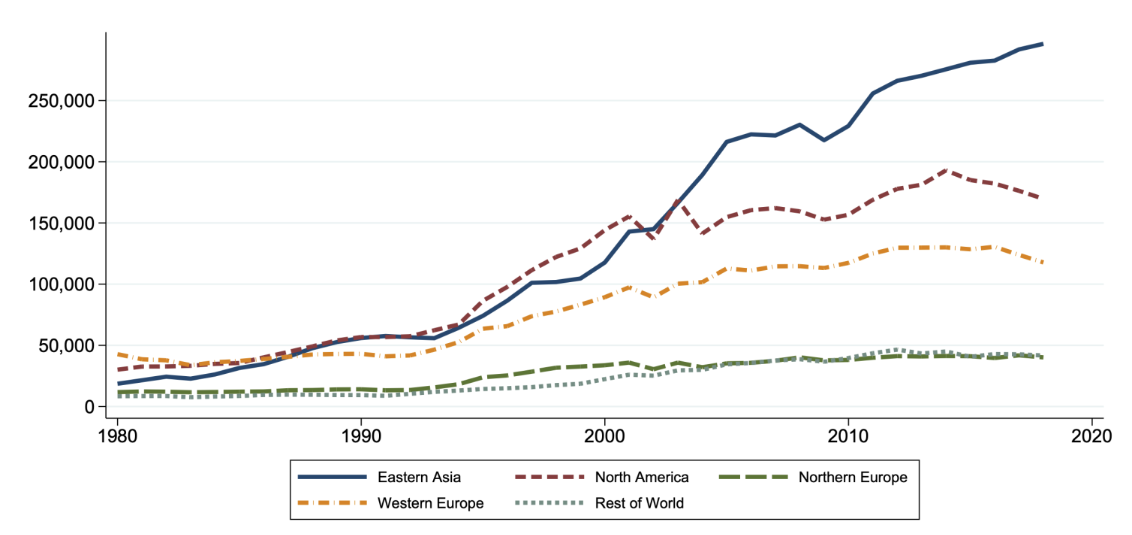
b) East Asia
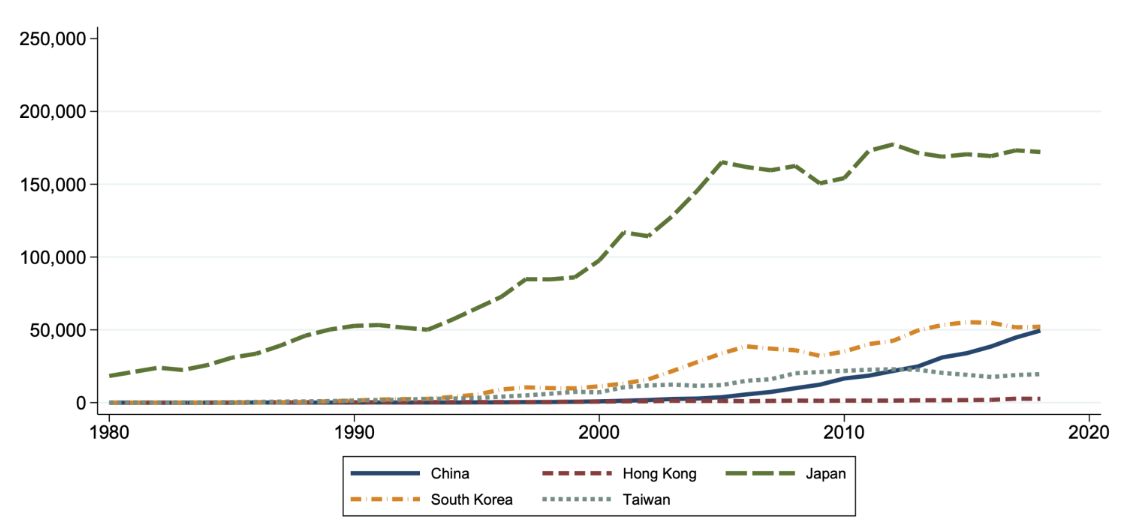
Source: Authors’ elaboration using INPAC-S dataset. Note: Left panel shows cross-border patent applications filed by countries of different regions of the world economy. Right panel shows patent applications filed by each country in East Asia
Third, East Asia has also emerged as a destination of cross-border patent applications, suggesting that the region may be considered a competitive destination to traditionally innovative countries such as the US (Figure 3). Nevertheless, while Chinese innovators predominately seek protection domestically, innovators in Japan, the US, Germany, and South Korea tend to seek protection abroad (Figure 1).
Figure 3 Main destinations of cross-border patents in the 2010s
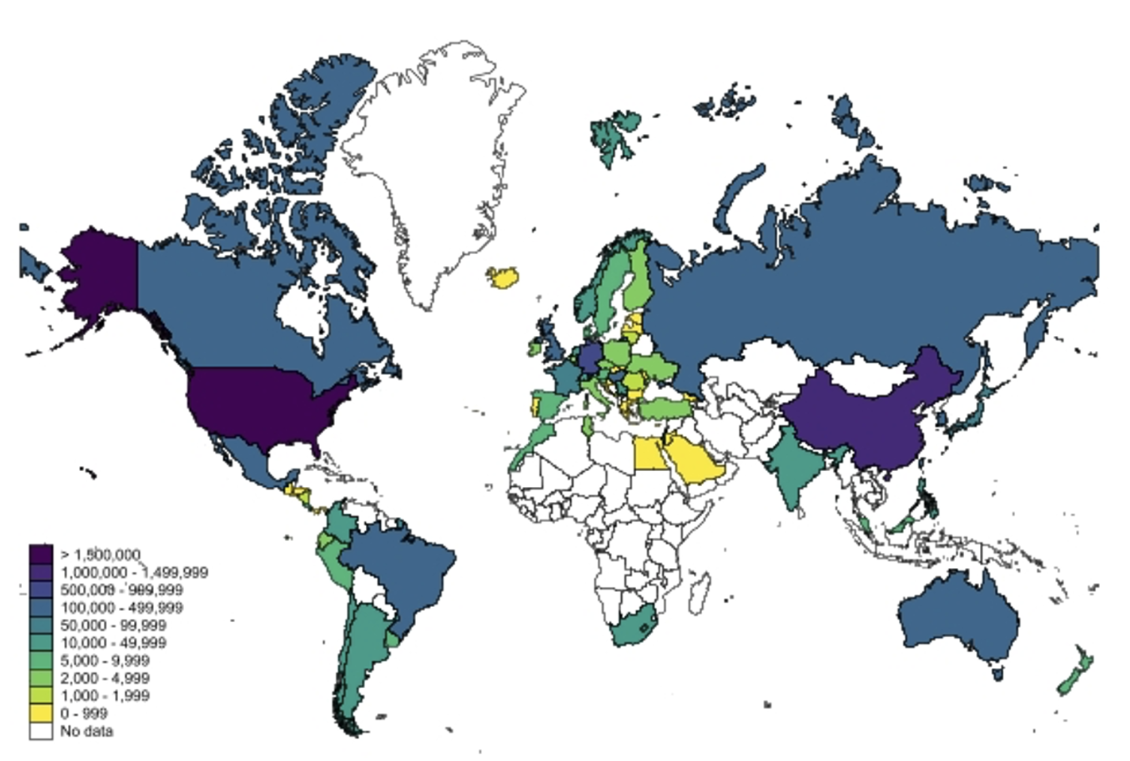
Source: Authors’ elaboration using INPAC-S dataset. Note: Number of cross-border patent applications received in the 2010s.
Strong but uneven increase in bilateral cross-border patent flows
Guided by the major patterns that we discovered in the data, and informed by the gravity-type relationship that emerges from our theoretical model, we capitalise on the established developments in the related empirical literature (e.g. on trade, migration, and FDI) to quantify the effects of policy and globalisation on the bilateral frictions for cross-border patent flows.
Figure 4 visualises the main findings from our econometric analysis, where we have estimated the evolution of the total direct bilateral frictions (e.g. due to distance, policy, etc.) in cross-border patenting between rich countries (North) and poor countries (South) over the period 1986–2019. By construction, these estimates should be interpreted as direct effects of changes in bilateral patenting frictions on the volume of cross-border patents, conditional on controlling for all country-time-specific characteristics on the source and the destination side. While our empirical analysis encompasses the entire dataset spanning from 1985, we specifically concentrate on the period from 1995 to 2018, due to potential reliability concerns associated with patent data in earlier years.
Figure 4 Globalisation and North-South cross-border patenting

Source: Authors’ estimations using INPAC-S dataset. Note: Estimates of time-varying border effects by groups of countries. North = high- and upper-middle-income countries according to the World Bank classification for 2000. South = lower-middle- and low-income countries.
The results in the top-left panel of Figure 4 reveal that the reduction in bilateral patent frictions led to a staggering increase of more than 300% in the transfer of patents from North to South between 1995 and 2018, calculated as (exp(5.394 - 4.004) - 1) * 100 = 301%, where 5.394 and 4.004 are the estimates of the globalisation effects that we obtain for 1995 and 2018, respectively. The increase in cross-border patent flows between rich countries is relatively smaller, but still large in absolute terms (about 22%). Finally, as expected, we find no significant increase in cross-border patent flows (i.e. no decrease in bilateral patent frictions) from South to North or from South to South during the same period.
We also isolate and decompose the decrease in bilateral frictions due to policies and agreements such as the Trade-Related Aspects of Intellectual Property Rights (TRIPS) agreement, the Patent Cooperation Treaty, and various regional trade agreements. We find that these supranational policies have been effective in promoting cross-border patent flows. In fact, they fully account for the increase in patent flows from South to South and from North to North. However, the polices that we account for in our model only explain about one third of the increase in the cross-border patent flows from North to South, posing the question: what has been the main driver of the remarkable increase in cross-border patent flows from North to South.
Cross-border patents and cross-country income inequality
Armed with our partial estimates, we employ our theoretical model to address two questions. First: what would the trajectory of cross-border patenting from North to South have been between 1995 and 2018 if the estimated globalisation trends had remained at their 1995 levels? Second: what are the welfare implications of the increased patent flows from North to South in our model?
Our counterfactual analysis yields several conclusions. First, in the absence of the globalisation effects we estimated, cross-border patenting would have experienced a significant 43% reduction by 2018. In other words, after accounting for general equilibrium effects, the 300% reduction in bilateral patenting frictions from North to South between 1995 and 2018 explains approximately 43% of the observed increase in cross-country patenting during that period. The interplay of globalisation forces and increased intellectual property protection has benefitted both North and South. By reducing the probability of imitation, the North experiences a surge in royalty payments from the South, leading to increased investment in R&D and subsequently boosting output in the North. Simultaneously, the South reaps the rewards of increased technology transfer from the North, resulting in the increased production of varieties and a subsequent boost in output. This underscores the substantial impact of globalisation trends on shaping the dynamics of cross-border patenting.
Second, our findings indicate that both North and South have experienced gains resulting from the cross-border transfer of patents. Notably, gains for the South were more pronounced in the aftermath of the 2000s. This suggests that cross-border patenting has played an important role in narrowing the real income gap between poor and rich countries.
References
Coleman, E (2022), “The Effects of Multilateral IP Treaties on Patenting Behavior”, Vanderbilt University Department of Economics Working Paper.
Howard, J, K E Maskus and W C Ridley (2023), “Intellectual property related PTAs and patenting”, in A Fernandes, N Rocha and M Rita (Des), Beyond Trade: How Deep Trade Agreements Shape Non-Trade Outcomes, London: CEPR Press.
LaBelle, J, I Martinez-Zarzoso, A M Santacreu and Y Yotov (2023), “Cross-border Patenting, Globalization, and Development”, Federal Reserve Bank of St. Louis, Working Paper No. 2023-031.
Manysheva, K, M Mestieri and E Berkes (2022), “It takes a village to create an idea: Knowledge spillovers and productivity over the past hundred years”, VoxEU.org, 13 August.
Nicita, A (2023), “International supply networks: A portrait of global trade patterns in four sectors”, UNCTAD, Working Paper No. 3.
Qiang, Z C, R Echandi and J Krajcovicova (2015), “Foreign direct investment and development: Insights from literature and ideas for research”, World Bank Blog, 24 November.




